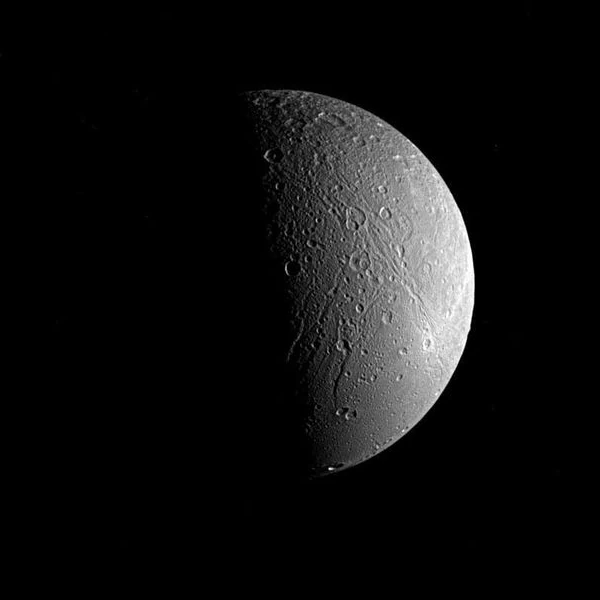
Dione, Saturn's fourth-largest moon with a diameter of 1,123 km, was discovered in 1684 by the astronomer Jean-Dominique Cassini (1625-1712). It orbits Saturn at an average distance of 377,400 km, with a revolution period of 2.7 days. Its surface, primarily composed of water ice, features bright cliffs and chasmata, suggesting past geological activity.
Unlike Enceladus, Dione shows no active cryovolcanism, but data from the Cassini mission (2004-2017) revealed traces of a subsurface ocean beneath its icy crust, about 100 km deep. This ocean, kept liquid by Saturn's tidal forces, could harbor conditions suitable for prebiotic chemistry.
With a density of 1.48 g/cm3, Dione is mainly composed of water ice (60%) and silicate rocks (40%). Its surface is marked by:
Surface temperatures hover around -186 °C, but thermal models suggest that its subsurface ocean could reach 0 °C near the rocky core.
Two hypotheses dominate to explain the formation of Dione:
The lineae visible on its surface indicate possible past tectonic activity, linked to gravitational interactions with Saturn and Rhea.
The Cassini probe made 5 flybys of Dione between 2005 and 2015, revealing:
The Dragonfly mission (NASA, planned for 2034) could include observations of Dione from Titan, while the ESA is considering a dedicated mission to Saturn's icy moons (Enceladus Orbilander).
| Moon | Diameter (km) | Distance from Saturn (km) | Subsurface ocean | Geological activity |
|---|---|---|---|---|
| Dione | 1,123 | 377,400 | Yes (100 km deep) | No current activity detected |
| Enceladus | 504 | 238,000 | Yes (10-30 km) | Active geysers |
| Tethys | 1,062 | 294,600 | Unconfirmed | Ancient fractures |
Sources: NASA - Dione Overview, ESA - Cassini-Huygens Mission, Nimmo et al. (2016) - Icarus.